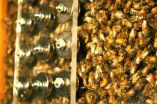Researchers explain mechanism behind rare muscle disorders
2010-12-14
(Press-News.org) Researchers have provided the first thorough mechanistic account of how a genetic defect leads to malignant hypothermia (MH) and central core disease (CCD), rare genetic skeletal muscle disorders. The study appears in the January issue of the Journal of General Physiology (www.jgp.org).
Mutations in the type 1 ryanodine receptor (RYR1), the calcium release channel of the sarcoplasmic reticulum (SR) activated during skeletal muscle excitation-contraction (EC) coupling, give rise to CCD. One of the most common CCD-causing mutations is Ile4895Thr. Now, Robert Dirksen (University of Rochester) and colleagues have provided a comprehensive analysis of the consequences of this mutation in muscle fibers of adult mice heterozygous for the mutation.
The team addressed several questions concerning how RYR1 function is altered by the Ile4895Thr mutation. Their findings demonstrate, for the first time, that the muscle weakness associated with MH and CCD arises from a dominant-negative effect, a reduction in the magnitude and rate of calcium release by the mutant RYR1 receptors during EC coupling. The reduction in calcium release in turn leads to reduced muscle force generation.
###
About The Journal of General Physiology
Founded in 1918, The Journal of General Physiology (JGP) is published by The Rockefeller University Press. All editorial decisions on manuscripts submitted are made by active scientists. JGP content is posted to PubMed Central, where it is available to the public for free six months after publication. Authors retain copyright of their published works and third parties may reuse the content for non-commercial purposes under a creative commons license. For more information, please visit www.jgp.org.
Loy, R.E. 2010. J. Gen. Physiol. doi:10.1085/jgp.201010523
END
ELSE PRESS RELEASES FROM THIS DATE:
2010-12-14
ST. PAUL, Minn. – Many people with incurable brain tumors use alternative therapies, such as taking vitamins and homeopathy, in addition to their conventional treatments, according to a study published in the December 14, 2010, print issue of Neurology®, the medical journal of the American Academy of Neurology.
About 40 percent of brain tumor patients in the study used alternative therapies including homeopathic remedies, vitamin supplements and psychological therapy.
"The use of these alternative treatments may be largely overlooked and underestimated," said study ...
2010-12-14
Folic acid can reduce birth defects including neural tube defects, congenital heart disease and oral clefts but some speculate high intakes of folic acid may be associated with adverse events such as colorectal cancer, states an article in CMAJ (Canadian Medical Association Journal) (pre-embargo link only) http://www.cmaj.ca/embargo/cmaj100568.pdf.
This study, conducted by researchers at Children's Hospital of Eastern Ontario Research Institute and The Hospital for Sick Children, is the first of its kind in more than three decades, to examine the folate status of Canadians ...
2010-12-14
Disease-management programs, which may include patient education, psychological intervention, dietary education, self-monitoring and telemedicine, can improve diabetes care, states an article in CMAJ (Canadian Medical Association Journal) (pre-embargo link only) http://www.cmaj.ca/embargo/cmaj091786.pdf.
The study, by French researchers, included 41 randomized controlled trials published between 1990 and 2009 with a total of 7013 patients.
The findings showed that disease-management programs are more effective than usual care in reducing glycated hemoglobin levels ...
2010-12-14
VIDEO:
This movie spotlights one waggle dance by a forager that had been sleep-deprived the
previous night. The average dance angle of this dance is superimposed over the dancer and variance around...
Click here for more information.
AUSTIN, Texas—In the busy world of a honey bee hive, worker bees need their rest in order to best communicate the location of food to their hive mates, research from The University of Texas at Austin shows.
"When deprived of sleep, humans ...
2010-12-14
SAN ANTONIO, Texas, U.S.A. (Dec. 13, 2010) — Scientists at the UT Health Science Center San Antonio restored learning and memory in an Alzheimer's disease mouse model by increasing a protein called CBP. Salvatore Oddo, Ph.D., of the university's Department of Physiology and Barshop Institute for Longevity and Aging Studies, said this is the first proof that boosting CBP, which triggers the production of other proteins essential to creating memories, can reverse Alzheimer's effects.
The finding, reported this week in Proceedings of the National Academy of Sciences, provides ...
2010-12-14
Boston, Mass. – It's widely recognized that fragmentation of medical information is a problem in health care, but the extent of the problem and how many patients may be at risk haven't been well quantified. In a new retrospective study, researchers at Children's Hospital Boston looked at adult acute care in Massachusetts and found that of 3.6 million adults visiting an acute care site during a five-year period, almost a third sought care at two or more different hospitals. These patients accounted for more than half of all acute care visits in the state, as well as more ...
2010-12-14
The number of people with asthma has increased sharply over the past few decades. It has been suggested that this is a result of decreased childhood exposure to microorganisms. A team of researchers — led by Dale Umetsu, at Harvard Medical School, Boston; Michio Shimamura, at the University of Tsukuba, Japan; and Petr Illarionov, at the University of Birmingham, United Kingdom — has now provided concrete evidence in mice to support this idea and identified an underlying mechanism to explain this protection, which the team hope could be exploited to develop ways to prevent ...
2010-12-14
Chronic myeloid leukemia (CML) was transformed from a fatal disease to a chronic condition by the development of a drug known as imatinib, which targets the protein that drives this disease (BCR-ABL). However, imatinib does not cure patients, they must take the drug lifelong, as disease recurs if they stop taking it. This is because imatinib does not kill all the CML cells; some, which are known as CML stem cells, persist. A key to therapeutically targeting CML stem cells is knowing whether they rely on BCR-ABL to persist. Answers to this will determine whether more effective ...
2010-12-14
EDITOR'S PICK: A benefit of 'flu: protection from asthma?
The number of people with asthma has increased sharply over the past few decades. It has been suggested that this is a result of decreased childhood exposure to microorganisms. A team of researchers — led by Dale Umetsu, at Harvard Medical School, Boston; Michio Shimamura, at the University of Tsukuba, Japan; and Petr Illarionov, at the University of Birmingham, United Kingdom — has now provided concrete evidence in mice to support this idea and identified an underlying mechanism to explain this protection, which ...
2010-12-14
DURHAM, N.C. – Imposing higher taxes on sodas and other sweetened drinks may generate a lot of money – but would lead to only minimal weight loss among most people and would have no effect on weight among consumers in the highest and lowest income groups, according to new research from Duke-National University of Singapore (NUS) Graduate Medical School.
The study, led by Eric Finkelstein, PhD, associate professor of health services at Duke-NUS, looked at the differential impact on calories and weight of a 20 percent and 40 percent tax on sodas and other sweetened beverages ...
LAST 30 PRESS RELEASES:
[Press-News.org] Researchers explain mechanism behind rare muscle disorders

